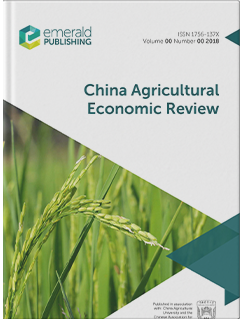The impacts of caterpillar fungus income on grazing pressure in Tibetan regions: a tale of income diversification
IF 4.6
2区 经济学
Q1 AGRICULTURAL ECONOMICS & POLICY
引用次数: 0
Abstract
PurposeThis research examined the impacts of diversified income from trading caterpillar fungus on pastoral households' livestock production and income. The specific objectives were to identify the main factors underlying participation in caterpillar fungus trade and to explore the impacts of a diversified income from trading fungus on livestock production activities and income.Design/methodology/approachData were collected from a pastoral household survey (n = 503) in five Tibetan Autonomous Prefectures. The authors employed propensity score matching (PSM) procedures to estimate the effects of participation in trading caterpillar fungus.FindingsPastoral households participating in caterpillar fungus activities maintain smaller herds, sell fewer animals for profit, slaughter more livestock for family consumption and experience fewer livestock deaths compared to nonparticipants. There is also some evidence that pastoral households participating in caterpillar fungus activities have a higher annual income compared to nonparticipants.Research limitations/implicationsA direct measure of grassland degradation was not included due to the data limitation. The estimated average treatment effects could differ under different observed households' characteristics.Originality/valueThis study fills a gap in the literature on the impacts of diversified income on livestock production activities. The authors provide a new perspective on the controversy over the extraction of caterpillar fungus. This study contributes to exploring the dual role of income diversification in addressing poverty and grassland resource degradation for Tibetan pastoral communities.毛虫菌收入对西藏地区放牧压力的影响:收入多样化的故事
目的研究冬虫夏草交易多元化收入对农户畜牧业生产和收入的影响。具体目标是确定参与冬虫夏草贸易的主要因素,并探讨冬虫夏草贸易带来的多样化收入对畜牧生产活动和收入的影响。设计/方法/方法数据来自5个藏族自治州的牧民家庭调查(n = 503)。作者采用倾向得分匹配(PSM)程序来估计参与交易冬虫夏草的影响。研究发现,与不参与冬虫夏草活动的家庭相比,参与冬虫夏草活动的家庭维持较小的畜群,出售更少的牲畜以获取利润,屠宰更多的牲畜供家庭消费,牲畜死亡人数更少。也有一些证据表明,参与冬虫夏草活动的牧民家庭的年收入高于不参与冬虫夏草活动的牧民家庭。研究局限/启示由于数据有限,未包括草地退化的直接测量。在不同的观察家庭特征下,估计的平均处理效果可能会有所不同。原创性/价值本研究填补了多元收入对畜牧生产活动影响的文献空白。作者对冬虫夏草提取的争议提供了一个新的视角。本研究有助于探索收入多样化在解决藏族牧区贫困和草地资源退化问题中的双重作用。
本文章由计算机程序翻译,如有差异,请以英文原文为准。
求助全文
约1分钟内获得全文
求助全文
来源期刊

China Agricultural Economic Review
AGRICULTURAL ECONOMICS & POLICY-
CiteScore
9.80
自引率
5.90%
发文量
41
审稿时长
>12 weeks
期刊介绍:
Published in association with China Agricultural University and the Chinese Association for Agricultural Economics, China Agricultural Economic Review publishes academic writings by international scholars, and particularly encourages empirical work that can be replicated and extended by others; and research articles that employ econometric and statistical hypothesis testing, optimization and simulation models. The journal aims to publish research which can be applied to China’s agricultural and rural policy-making process, the development of the agricultural economics discipline and to developing countries hoping to learn from China’s agricultural and rural development.
 求助内容:
求助内容: 应助结果提醒方式:
应助结果提醒方式:


